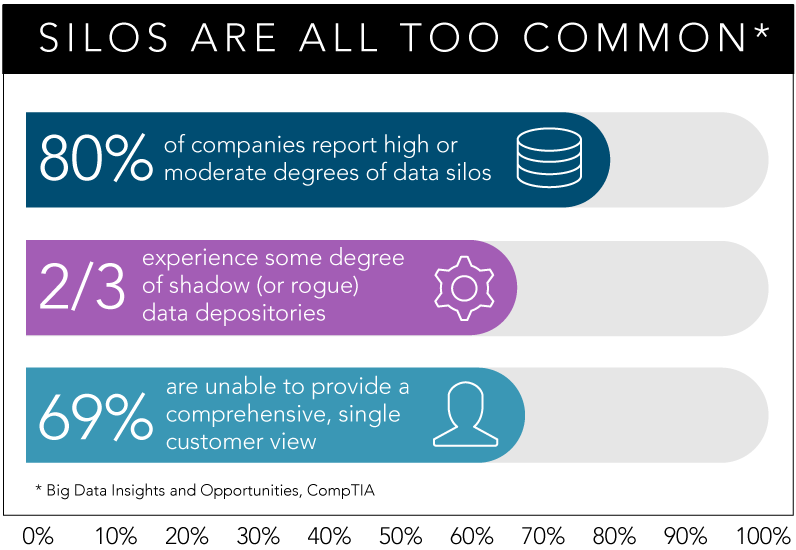Are Data Silos Killing Your Business?

5 Steps to Tear Them Down, Connect Data, and Activate Results
Data is the most powerful four-letter word in business. That’s because data has the potential to transform every facet of the organization. But for all its hype, the full promise of data rarely comes to fruition because of a more sinister four-letter word: “silo.”
Enterprises try to glean insights from data that’s trapped in the silos that exist across business units, organizational functions, and CRM systems. Unfortunately, silos have made it hard to manage, analyze, and activate enterprise-wide data, which hampers the identification of valuable sales and marketing opportunities that spark growth and drive results.

Data silos tend to arise naturally in organizations because each department has different goals, priorities, responsibilities, and systems. And every department works in its own way, which only exacerbates the problem.
More often than not, the overwhelming volume and velocity of data creates chaos instead of opportunity. Just think about the inherent pace of change in business today.

It’s no wonder 82 percent of organizations said that managing the volume, variety, and velocity of data is moderately to extremely challenging, according to a new study conducted by Forrester Consulting on behalf of Dun & Bradstreet.
This study, “The B2B Data Activation Priority,” shines a light on the significant challenges companies face in connecting, sharing, and converting their data into actionable insights. With feedback from over 500 B2B professionals with responsibility for/or influence over customer and prospect data strategy, the research demonstrates that while mature firms are making strides with how they use and activate their data, there are still many challenges to overcome before companies are able to effortlessly convert their data into actionable insight.

Not only is data constantly in flux, it’s a monumental challenge to capture that information – accurately and consistently – across every department.
Not only is data constantly in flux, it’s a monumental challenge to capture that information – accurately and consistently – across every department. It’s proven to be a laborious and intensive task to manage and maintain datasets spread across multiple applications and tools. In fact, according to the Forrester study, 80 percent of organizations said managing data and insight sharing across business areas is moderately to extremely challenging. With 67 percent of B2B firms citing their increased use of data and analytics as a critical priority over the next 12 months, it’s never been more important to get data strategy right – and use it as a catalyst for growth.
Sales teams typically have their preferred CRM or system to manage data, while marketing and finance prefer other systems that leverage customer data differently. Still, companies are investing billions of dollars on enterprise applications with the goal of getting a 360-degree view of the customer. But when data resides in multiple, disparate databases, it’s often inconsistent and poorly organized. According to the Forrester report, 72 percent of firms said managing multiple CRM systems across geographies/technology silos is moderately to extremely challenging.
Instead of getting a complete and accurate view of a customer or prospect, companies are enacting a strategy that is often informed by information that’s contradictory, misleading, or altogether wrong. This siloed nature of enterprise-wide data management fouls up operations and decision-making every time; so much so, that data is not always the guiding factor in key business decisions. In fact, only half of B2B marketing and sales decisions are made using data.
The Forrester study found that, on average, B2B marketers and sellers are basing 48 percent of decisions on intuition or personal/company experience rather than on quantitative information and analysis. Their reasons vary for trusting their personal experience over data analysis. For example, one US-based director in pharmaceuticals felt that account-based selling is relationship oriented, so intuition and experience made more sense to him. A UK-based finance director said his firm “lacks the culture and confidence to rely on fact-based marketing.” These sentiments were echoed by many survey respondents. Only 49 percent of B2B marketers and sellers said their organization was effective at providing customer data they can fully trust to be complete and accurate, according to the Forrester study.

Data management policy, tools, and process need to be considered and implemented across systems (silos) rather than developed as one-offs.
Despite these challenges, the data-driven mandate for organizations is clear. Therefore, in order for companies to maximize the full potential of data and activate insight for decision-making, organizations must break down data silos and connect disparate databases to create a single, complete, and connected view of their business relationships. Data management policy, tools, and process need to be considered and implemented across systems (silos) rather than developed as one-offs. Chipping away at these pesky silo walls is no easy task, but the following steps should help get your organization on the right track.
1. Employ a Data Evangelist
It’s clear from the research that companies need executive-level support to prioritize data strategy. Therefore, every enterprise needs to consider employing a single data leader that ties the disparate departments together, so they can take the information to the next level. Ultimately, there should be someone who interacts with each of the organizational leaders, from marketing to finance, who can help distill the information and turn intelligence into insight. Within large enterprises, it may fall under the responsibility of the Chief Data Officer or a head of insights. Smaller companies may not have this leader in place, but there should be somebody who can identify the data and analytics that can sift compelling insights from the noise and who understands how it can be used to drive value across the enterprise. This person should be also responsible for decisions governing steps 2 and 3.
2. Institute Common Data Standards
It’s important for everyone to be on the same page with respect to how data is defined and collected. There must be common standards leveraged across data assets, whether they are standards the company creates or established industry standards like SIC for industry, ISO for countries, or a D-U-N-S® Number for hierarchies. Adoption of standard datasets, models, schemas, and codes significantly decreases time to value and complexity within your data supply chain.
Without the benefit of these defined standards, also known as having a common master data dichotomy or customer ID, data valuable to one department may not be recognized by another. What’s more, inconsistent naming conventions can lead to duplicate records. As a result, the information and data output of these systems may render rich details but cannot be used accurately. When teams use a shared, defined set of key performance indicators (KPIs) to measure outcomes, they support marketers’ need to deliver campaigns and sellers’ need to relate to individual buyers at scale.
3. Make It Universal
The days of having to preserve everything in one physical location/database are gone. Companies are leveraging common data standards and API technology to take data and pull it together on demand to create the required insight. This approach has transformed the way data is shared, eliminating in many cases the need for “pre-processing and/or conversion.”
This will allow data to flow from one system to another, giving businesses the freedom to collaborate and share information that can inform future insights.
4. Embrace Advanced Analytics
When asked what solution capabilities they consider to be very or extremely important in improving their data activation practices, respondents to the Forrester survey selected reporting and analytics as number one. After all, everyone has data – it’s a commodity. Insight, on the other hand, is the real asset. From predictive analytics to advanced data visualization techniques, companies who prioritize data activation reported greater emphasis than laggards on leveraging sophisticated analytics techniques that inform and speed up marketing and sales decisions and strategies.
As a decision-maker, you must always be pushing to improve your firm’s ability to activate data for decision-making. Being able to activate and share insight across an organization is the catalyst needed for companies to invest the time and resources needed to break down data silos.
5. Work With Trusted, Third-Party Partners
For customer data to be of any use, it must be complete, and when there are gaps, many firms supplement with and integrate external data capabilities from trusted partners. According to the Forrester survey, 65 percent of data-activation leaders engage third-party partners to help them extend their data and analytics capabilities faster and more effectively than they could using only their own resources; only 38 percent of laggards do the same.
Enlisting third-party data and analytics solution providers to help navigate change and implement new approaches often provides a cheaper and faster path than building those capabilities internally. Be sure to find partners who understand your strategies and are willing to not only “do” for your firm but teach you too. They’re called “partners” for a reason.
In Summary
Data is proving to be a valuable resource in your mission to grow the business. But turning that information into valuable insight requires high quality, dependable, and accurate data. By breaking down the silos within your organization, you’ll be able to identify untapped opportunities that can be shared across the enterprise. But remember, the answer is not just about having the right technology. It’s about the combination of technology, people, and process that defines your competitiveness and the ability to transform your business.
While challenges with data management, insight sharing, and actionable insight development are common problems that all respondents identified with, a portion of them – the companies more likely to describe their firms as effective across key people, process, and technology considerations – report better outcomes than the rest. These data-activation leaders say they’re good at using their data to make decisions, such as accurately attributing campaign success or personalizing experiences. They are also more likely to report increases across key marketing, sales, and customer metrics, such as sales cycle speed, return on marketing spend, and customer loyalty.
Check out the full report to gain an in-depth summary of what data activation leaders are doing to reap the benefits from breaking down silo walls.


